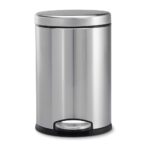The Unsung Heroes of Hygiene: Dustbin Manufacturers Keeping Our World Clean

Submit Your Details Here
In the bustling urban landscapes and serene suburban neighborhoods, there exists an unsung hero, silently but indispensably contributing to the cleanliness and hygiene of our surroundings—the humble dustbin. Yet behind every strategically placed bin lies a story of innovation, sustainability, and dedication. This narrative often remains unexplored, overshadowed by the mundane nature of its subject. Today, we shed light on the pivotal role played by dustbin manufacturers in shaping our environments and promoting a healthier planet. If you are looking for the best dustbin manufacturer in Delhi, India. Contact Mumma’s Life Today!
The Genesis of Hygiene Warriors
Dustbin manufacturing is more than just a business; it’s a commitment to societal well-being. These manufacturers are the architects of cleanliness, envisioning and crafting receptacles that serve as the first line of defense against environmental degradation. From the conception of designs to the final production, every step is meticulously executed to ensure efficiency and durability.
In the early days, dustbins were rudimentary in design, primarily serving the purpose of waste containment. However, as environmental consciousness grew, so did the need for innovation in waste management. Dustbin manufacturers rose to the challenge, integrating sustainable materials, ergonomic designs, and advanced technologies into their creations.
Engineering Sustainability, One Bin at a Time
Sustainability is at the core of modern dustbin manufacturing. With the ever-increasing threat of climate change, these manufacturers have embraced eco-friendly practices, opting for recyclable materials and energy-efficient production processes. From biodegradable plastics to reclaimed metals, the materials used in dustbin construction are chosen with environmental impact in mind.
Furthermore, dustbin manufacturers actively promote recycling initiatives by designing bins with separate compartments for different types of waste. This not only streamlines the recycling process but also encourages individuals to adopt eco-conscious habits in their daily lives. Through their innovative designs, dustbin manufacturers are paving the way towards a greener future.
The Intersection of Form and Functionality
In the realm of dustbin manufacturing, aesthetics are not overlooked. Today’s bins are more than mere containers; they are functional works of art seamlessly integrated into their surroundings. Whether adorning city streets, parks, or office complexes, dustbins are designed to complement their environments while remaining highly functional.
Manufacturers employ a blend of form and functionality, considering factors such as capacity, accessibility, and weather resistance. From sleek, minimalist designs to bold, statement pieces, there’s a dustbin to suit every setting. This meticulous attention to detail ensures that bins not only serve their primary purpose but also enhance the visual appeal of their surroundings.
Innovations Driving the Future of Waste Management
The landscape of waste management is constantly evolving, and dustbin manufacturers are at the forefront of this transformation. Cutting-edge technologies such as sensor-based monitoring systems and automated waste sorting mechanisms are revolutionizing the way we manage and dispose of waste.
Sensor-equipped bins can detect when they are nearing capacity, alerting waste management authorities for timely emptying. Similarly, automated sorting systems utilize artificial intelligence to segregate recyclable materials from general waste, streamlining the recycling process and reducing landfill dependency. These innovations not only improve efficiency but also contribute to resource conservation and pollution reduction.
Partnering for Progress: Collaborations with Municipalities and Businesses
Dustbin manufacturers don’t operate in isolation; they collaborate closely with municipalities, businesses, and community organizations to optimize waste management strategies. By understanding the unique needs and challenges of different environments, manufacturers can tailor their solutions to maximize effectiveness.
Public-private partnerships play a crucial role in implementing comprehensive waste management systems. Manufacturers work hand-in-hand with local authorities to identify high-traffic areas, assess waste generation patterns, and deploy strategically placed bins. Moreover, collaborations with businesses facilitate the integration of waste management solutions within corporate environments, promoting sustainability across sectors.
Conclusion: Celebrating the Unsung Champions of Cleanliness
In the tapestry of modern society, dustbin manufacturers may seem like inconspicuous threads, but their contributions are woven into the fabric of our daily lives. From bustling metropolises to serene countryside retreats, their creations stand as silent sentinels, guarding against the tide of waste and pollution.
As we navigate the complexities of environmental stewardship, let us not forget the pivotal role played by these unsung champions of cleanliness. Behind every bin lies a story of innovation, sustainability, and dedication—a testament to the enduring commitment of dustbin manufacturers towards building a cleaner, healthier planet for generations to come.









